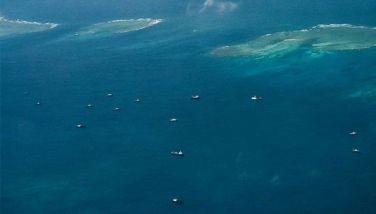Typhoon names? No shortage here
 We may still lack rain, but we certainly don’t lack names for typhoons.
We may still lack rain, but we certainly don’t lack names for typhoons.
The list of names given to tropical cyclones that will come within the Philippine Area of Responsibility (PAR) all the way to the year 2016 had been prepared as early as 2000.
The names come in four-year cycles, meaning typhoons in 2001, 2005, 2009, and 2013 bear the same names in alphabetical sequence.
The list was slightly revised in 2005.
Typhoons to hit the country this year have the following names: Amang, Bebong, (formerly Batibot), Chedeng, Dodong, Egay, Falcon, Goring (formerly Gilas), Hanna (Harurot), Ineng, Juaning, Kabayan, Lando (Lakay), Mina (Manang), Nonoy (Nina), Onyok, Pedring (Pogi), Quizel, Ramon (Roskas), Sandong (Sikat), Tisoy, Ursula, Viring, Weng, (Wang-Wang), Yoyoy, and Zigzag.
Some names in the auxiliary list of typhoons for this year have also been changed. An auxiliary list is used in the event that the number of tropical cyclones within the year exceeds the number of Filipino alphabet letters, which is 25.
The 10 names in the auxiliary list for this year are Abe, Berto, Charo (formerly Charing), Dado (Danggit), Estoy, Felion (Fuago), Gening, Hantik (Herman), Irma (Irog), and Jaime (Joker).
The 140 names (100 official and 40 auxiliary) assigned to the cyclones that will cross the country in the first 16 years of the 21st century were among 18,000 entries submitted by participants in the “Name a Bagyo Contest” launched in 1999 by the Department of Science and Technology and the Philippine Atmospheric, Geophysical and Astronomical Services Administration (DOST-Pagasa).
In the nationwide search for new generation typhoon names, no gender biased local names were noted.
Historical records show that cyclones used to be named after women, a practice started by Australian weatherman C. Wragge before the end of the 19th century. Before 1890, the world’s cyclones were arbitrarily named.
Naming storms became so popular that Air Force and Navy forecasters gave their wives and girlfriends the distinction of having storms named after them.
In 1942, the
However, DOST-Pagasa noted a rare occurrence in 1946 when three storms developed simultaneously in the western North-Pacific basin where the Philippine territory is located.
“Instead of names, all three were identified based on location,” DOST-Pagasa said. “This caused confusion because the public could not identify which storm was being reported. Early the next year, after that rare case, weather forecasters decided to identify storms using names in alphabetical order.”
In 1963, the then Philippine Weather Bureau adopted the system of having four groups of Filipino women’s nicknames ending in “ng” from A to Y as names for all tropical cyclones occurring within the Philippine Area of Responsibility.
Those four sets of names were then repeated every four years.
Moreover, each group was accompanied by an auxiliary list from A to J in the event that the number of typhoons occurring in a particular year exceeded the number of Filipino alphabet letters.
The 1999 “Name a Bagyo Contest” further systematized the naming of cyclones.
“Our ultimate aim of issuing local names,” Pagasa said, “is to inform national and local disaster coordinating councils and the public of the presence of such cyclones and immediately enable them to implement their disaster preparedness plan and undertake necessary precautionary actions.”
The names now being used are the citizens’ choices, since most of these names came from those who joined and won in the “Name a Bagyo Contest,” it added.
- Latest


























